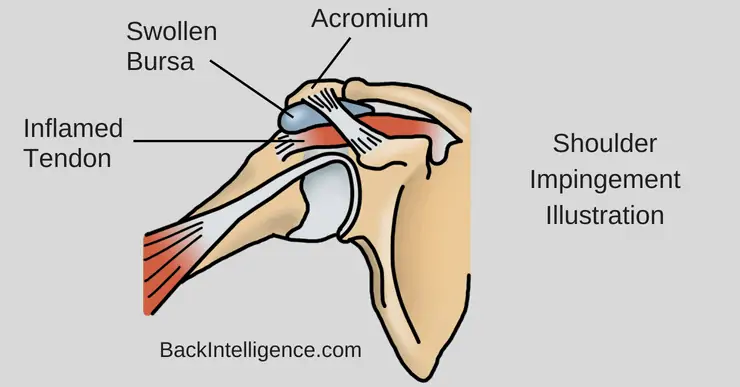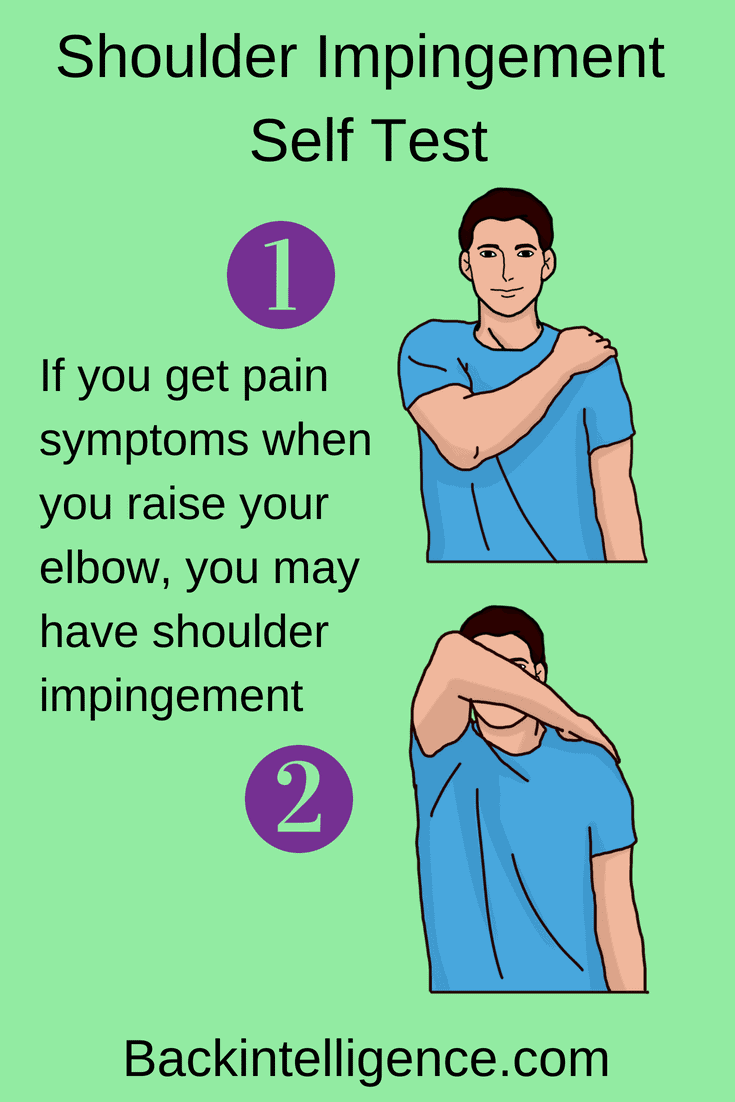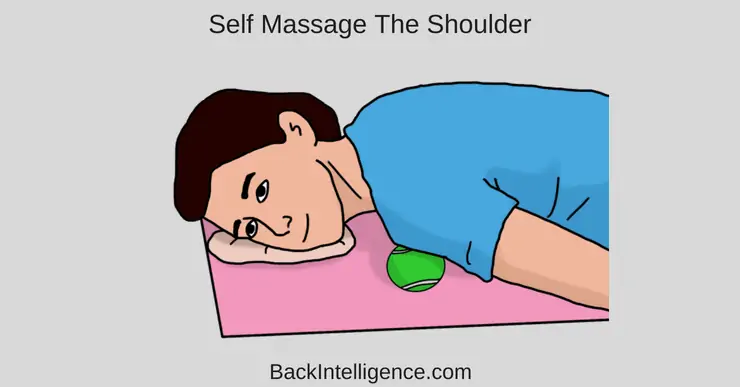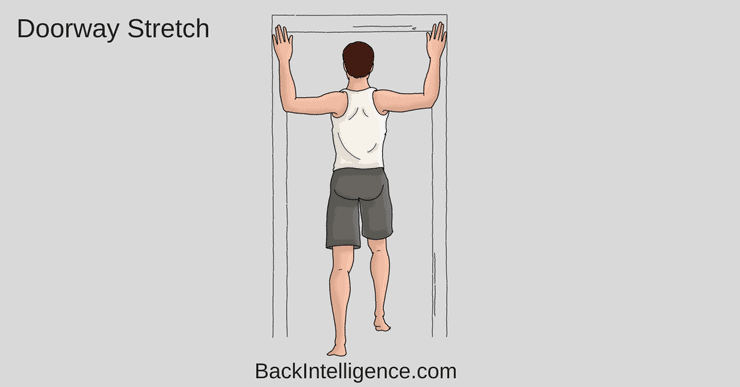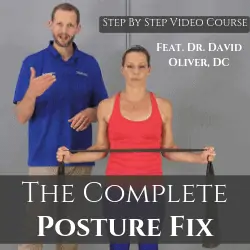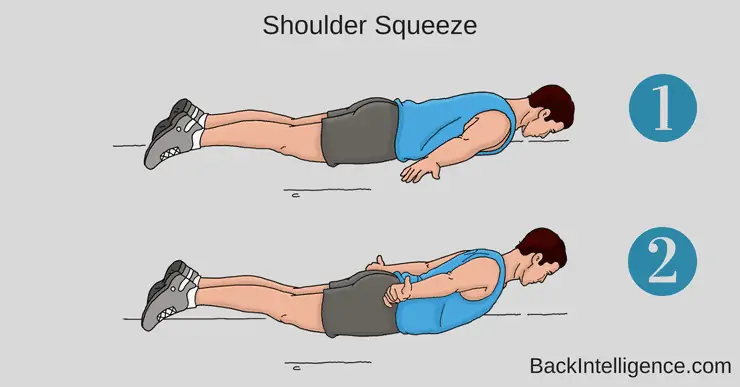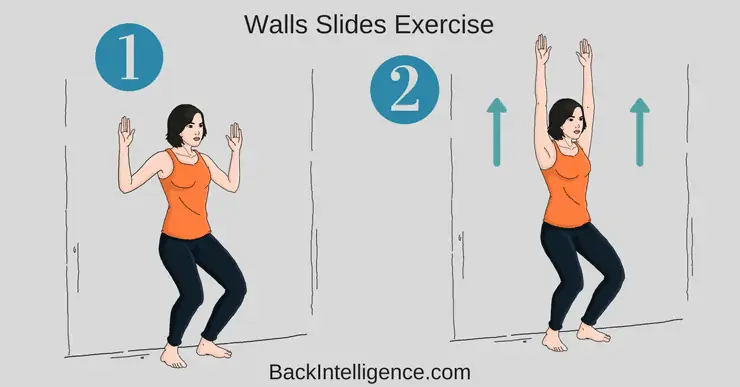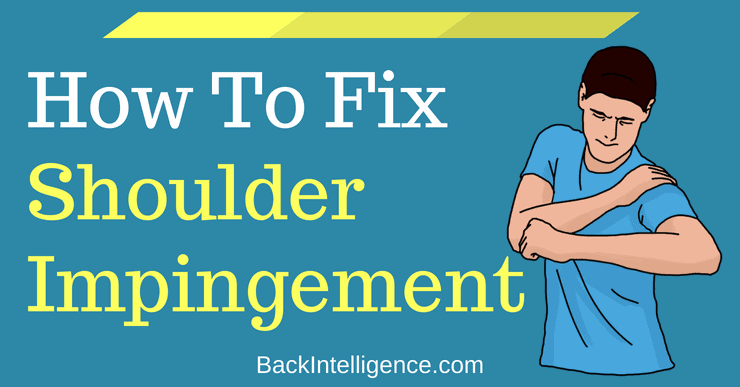
Shoulder impingement syndrome (aka Subacromial Impingement Syndrome) is one of the most common causes of shoulder pain resulting in loss of range of motion and function. Those who have shoulder impingement usually complain of pain exacerbated by lying on the painful shoulder and/or when reaching the arm overhead.[1][2]
Normal daily activities such as combing one’s hair, showering, or reaching up into a cupboard can become painful. A general loss of strength may be noted as well.[1]
The good news is that with the simple shoulder exercises below, you can ease your pain. First let’s discuss this condition a little more.
Shoulder impingement is a general term used to describe the irritation or injury of structures in the shoulder and subacromial space. Some examples include, but are not limited to, rotator cuff tendinosis (irritation of the muscle to bone connection), tears of the rotator cuff (partial or full tear of muscle to bone connection), and bursitis (inflammation of the fluid filled sacs that surround the shoulder).[1][2]
See Image Below for Subacromial space illustration:
What are the Main Causes of Shoulder Impingement?
- Altered shoulder movement patterns which might be associated with imbalances, weakness, or tightness of the muscles involved in moving the shoulder.[2]
- Poor posture.[2]
- Overuse.[2]
- Repetitive overhead movements, such as golfing, throwing, racquet sports, swimming and frequent overhead reaching or lifting.[3]
- An acute injury to the shoulder (or Trauma).[3]
- Degeneration of the joints in the shoulder causing osteophyte formation – these are bony fragments that are causing a narrowing of the space.[3]
- Bony abnormalities of the acromion, which narrow the subacromial space.[2]
Self Test For Shoulder Impingement:
This is a very similar to the well known Hawkins Kennedy shoulder impingement test, but you can do this one on your own.
Self Test Instructions:
1. Take the hand on the affected side and place in on the opposite shoulder (the shoulder with no pain). Your elbow should be bent and resting down toward your chest.
2. Now try to lift the elbow up, toward your face.
3. If this causes pain, it suggests that a shoulder impingement is likely behind your troubles.
Check out these 3 Tests for Shoulder Impingement
How To Fix Shoulder Impingement?
Icing + Self Massage + Exercises
FIRST, Start With Icing (To help inflammation)
Ice can be applied via cold pack, ice pack, or ice cup massage. Ice is for calming down the inflammation in the area. Over the counter NSAIDs can also help with this.[1] It is always important to check with your doctor to see if NSAIDs are right for you.
SECONDLY, Self massage with a ball to alleviate immediate pain.[2]
• Areas to self-massage include: The Biceps muscle, Deltoids (which lie on the front, side and back of the shoulder), and Pectoral muscles (Chest muscles). If you are new to this, start by using a tennis ball since it is slightly soft. If you are more advanced, progress to a firmer ball such as a lacrosse ball or frozen softball.
• Caution: Avoid rolling the massage ball over the bony points of the shoulder where the inflamed tendons are.
See images below for some of the areas to massage:
This will release tight pectoralis major and minor (chest muscles) that are usually very tight in rounded shoulder posture.
- Place a self-massage ball or Lacrosse ball against a wall at your chest level.
- Press your chest against the ball
- Locate a tight spot to apply pressure to.
- Stay on that spot for 30-60 sec, and breathe.
- Move the ball to another tight spot on your chest and hold again for 30-60 sec.
- Continue finding tight spots around chest/shoulder area and work on them.
THIRD, 5 Shoulder Impingement Exercises[2]
One of the most overlooked causes of shoulder pain is stiff, tight, and overworked tendons of the upper body musculature. Therefore, after calming the pain down (as we did above), try the following exercises:
1. Doorway Stretch (Chest Stretch)
The doorway stretch will help loosen up your chest area and shoulders.
How to do it:
– Position your elbows and hands in line with a doorframe.
– Step through the door slowly, until you feel a stretch.
– Hold this end position for 15 to 20 seconds before returning to the starting position.
– Repeat this stretch 3 times.
Exercise #2: Thoracic Extension Variation 1
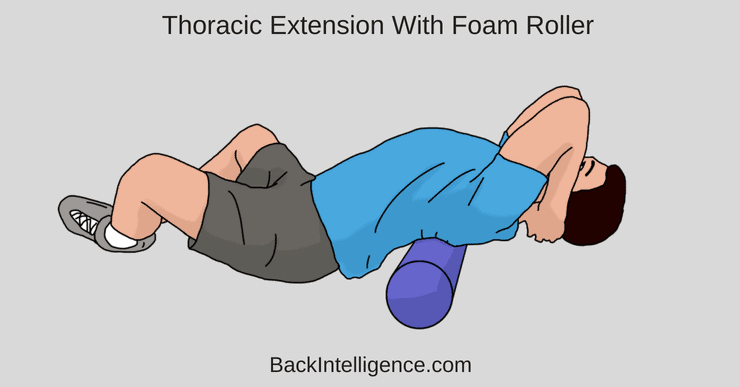
How to do it:
– Use a foam roll or a rolled up yoga mat.
– Lie down on your back with your knees bent, feet on the floor, and have the foam roll just underneath your shoulder blades.
– Bring your hands behind your head and perform the “J-loop” as you extend your thoracic spine over the foam roll.
– Hold for 5-10 seconds and repeat 10 times.
The Complete Posture Fix (With Dr. Oliver)
Fix your Rounded shoulders & Fwd Head posture, get out of pain and increase your mobility.
Learn More
Exercise #3: Strengthen rotator cuff muscles
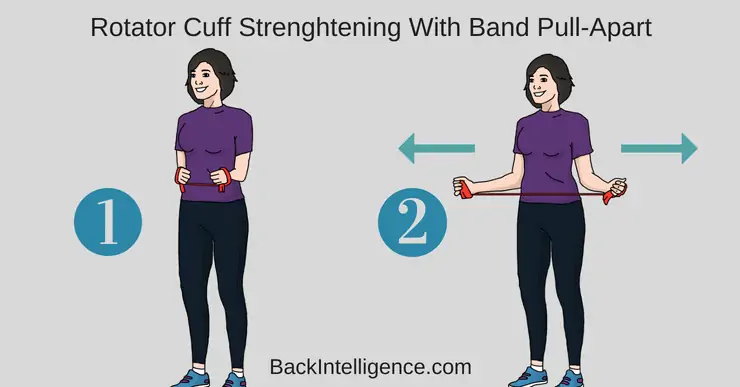
How to do it:
– Begin standing at wall with elbows in at side and palms up holding resistance band.
– Squeeze shoulder blades together and pull band apart by externally rotating shoulders.
– Keep the forearms tucked in the whole time, meaning there should not be much space between the elbow and your body.
– Strive for 10 reps and do 3 sets.
Exercise #4: Floor Cobra Raises
This exercise is meant to strengthen your middle and lower trapezius muscles, which will help you maintain a good posture.
How to do it:
– Lie face down with your palms resting on the floor, palms down.
– Slow externally rotate your arms, and lift them up off the floor.
– Squeeze your shoulder blades and hold for 1-2 seconds.
– Repeat 10 times and do 3 sets.
Exercise #5: Wall Angels
This exercise strengthens the low trapezius muscles and serratus anterior as well as opens up the shoulders and chest.
How to do it:
– Stand with your back to the wall and try to keep your upper back and buttocks in contact with the wall and walk your feet out about 12 inches from the wall.
– Draw-in your belly toward the wall, as to avoid an excessive arch in the low back.
– Bend your elbows to 90 degrees so that your hands are pointing up, and try to press your forearms against the wall (this may be an uncomfortable position when you first start performing this exercise)
– Slowly slide your arms up the wall and then back down the wall.
– Begin with 1 set of 10 repetitions and work your way up to 3 sets of 10 repetitions.
We hope you enjoyed these shoulder impingement exercises and that they will work for you.
Video – Shoulder Impingement Treatments:
Learn More
Rounded shoulders exercises
Causes of poor posture
Upper back stretches
How to get rid of neck pain
Sources:[1] Koester M, George M, Kuhn J. Shoulder impingement syndrome. Am J Med. 2005;118(5):452-455. doi:10.1016/j.amjmed.2005.01.040
[2] McClure P, Bialker J, Neff N, Williams G, Karduna A. Shoulder function and 3-dimensional kinematics in people with shoulder impingement syndrome before and after a 6-week exercise program. Phys Ther. 2004;84(9):832-848. doi:10.1093/ptj/84.9.832
[3] Khan Y, Nagy M, Malal J, Waseem M. The painful shoulder: Shoulder impingement syndrome. Open Orthop J. 2013;7(1):347-351. doi:10.2174/1874325001307010347
Dr. Smith earned his Doctorate In Physical Therapy from the University of Miami’s Miller School of Medicine and currently practices as a home care therapist in the Tampa Bay area. He uses his eclectic background of working with everyone from those in the ICU to elite athletes to customize care for each one of his patients and progress them toward their personal goals.
Prior to being a Physical Therapist, he earned a masters degree in public health and managed big pharma clinical trials worldwide. He enjoys CrossFit, Animals, and helping people live a pain free and active lifestyle
